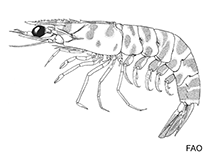Holthuispenaeopsis atlantica (Balss, 1914)
Guinea shrimpGoogle image | No image available for this species;
drawing shows typical species in Penaeidae.
Classification / Names Populärnamn | synonymer | CoL | ITIS | WoRMS
Malacostraca | Decapoda | Penaeidae
Environment: milieu / climate zone / djupintervall / distribution range Ekologi
; djupintervall 1 - 60 m (Ref. 8), usually 10 - 40 m (Ref. 8). Tropical, preferred 27°C (Ref. 107945); 16°N - 35°S, 18°W - 36°E (Ref. 111099)
Distribution Länder | FAO områden | Ekosystem | Förekomster | Utplanteringar
Eastern Atlantic and Western Indian Ocean: West African coast from Senegal to Angola and around the South African Cape to Mozambique.
Length at first maturity / Size / Weight / Age
Könsmognad: Lm 10.8, range 7 - ? cm Max length : 12.0 cm TL hane/ej könsbestämd; (Ref. 434); 17 cm TL (female); publicerad maxvikt: 23.18 g (Ref. 117292)
Life cycle and mating behavior Könsmognad | Reproduktion | Lek | Eggs | Fecundity | Larvae
Main reference
referenser | Koordinator | Medarbetare
Holthuis, L.B. 1980 FAO Species Catalogue. Vol. 1. Shrimps and prawns of the world. An annotated catalogue of species of interest to fisheries. FAO Fish. Synop. 125(1):271 p. Rome: FAO. (Ref. 8)
IUCN Red List Status
(Ref. 130435: Version 2025-1)
CITES status (Ref. 108899)
CMS (Ref. 116361)
Threat to humans
Human uses
Fiskeri: kommersiell
FAO - fiskeri: landings | FishSource | Sea Around Us
Verktyg
Ytterligare information
Max. ages / sizes
Length-weight rel.
Length-length rel.
Length-frequencies
Mass conversion
Abundans
Internet-källor
BHL | BOLD Systems | CISTI | DiscoverLife | FAO(fiskeri: ; publication : search) | Fishipedia | GenBank (genome, nucleotide) | GloBI | Gomexsi | Google Books | Google Scholar | Google | PubMed | Tree of Life | Wikipedia (Go, sök) | Zoological Record



